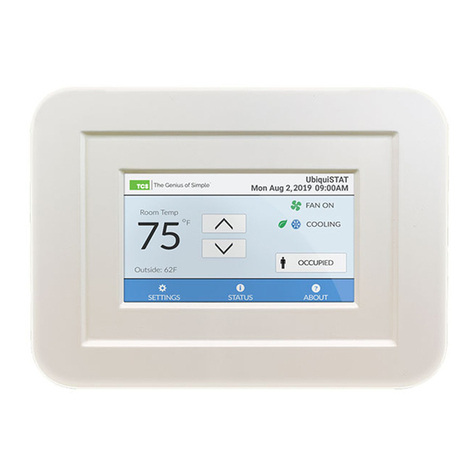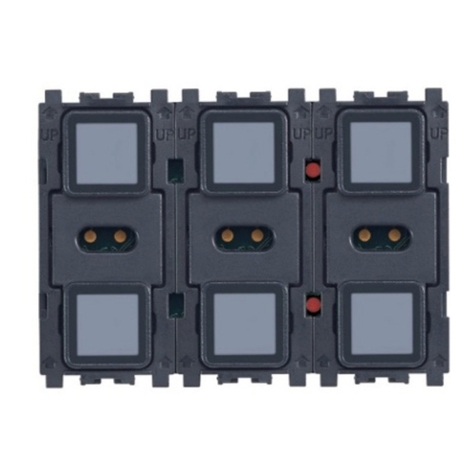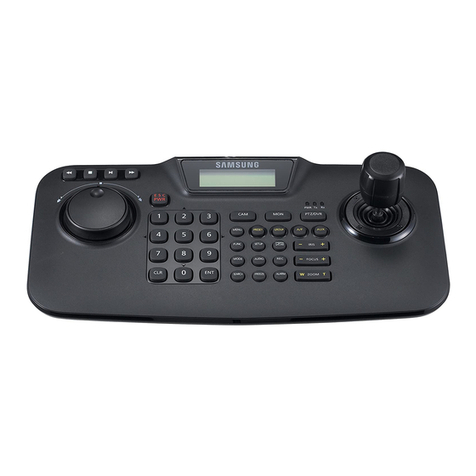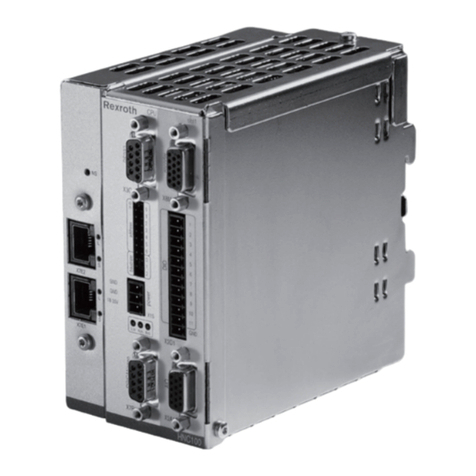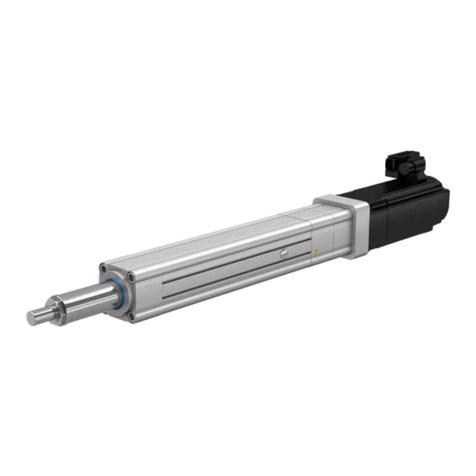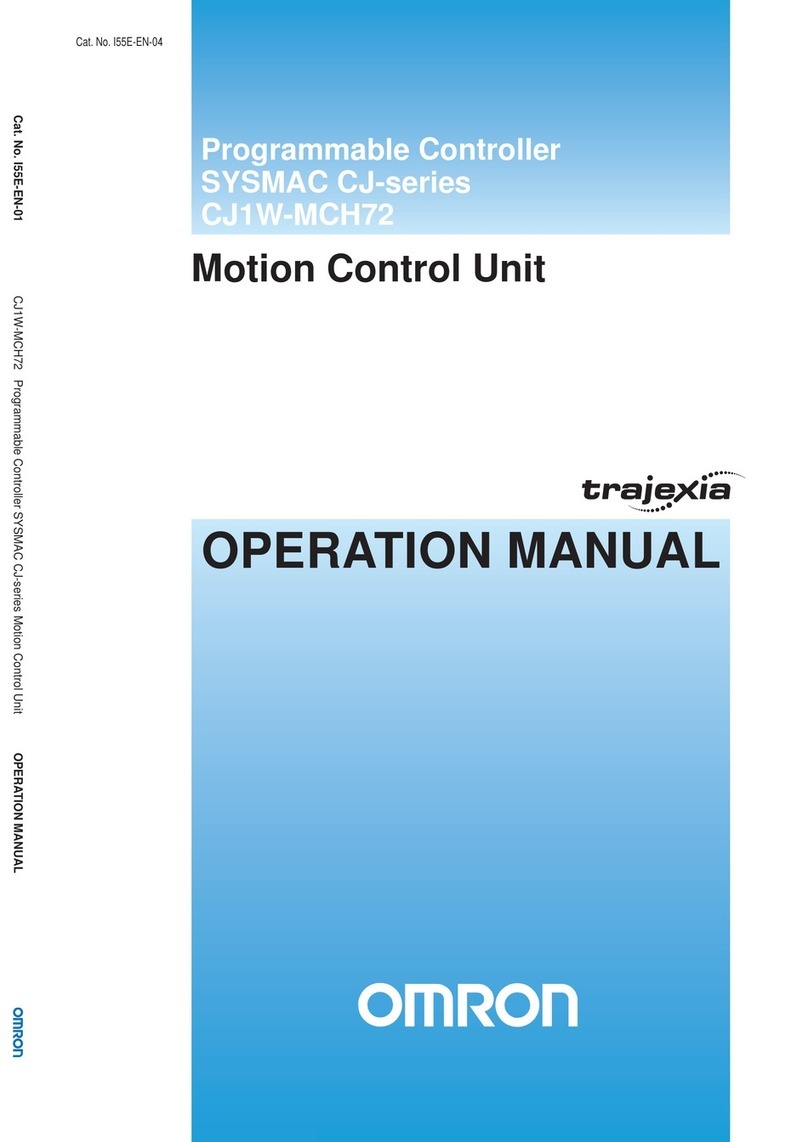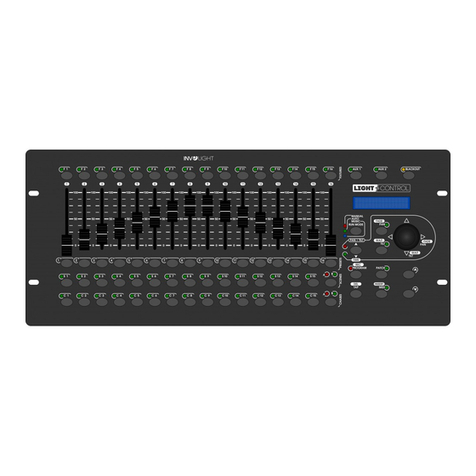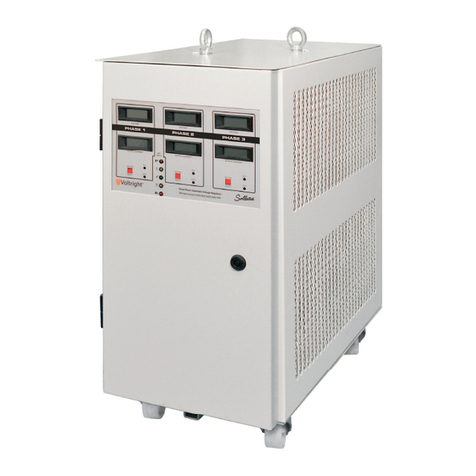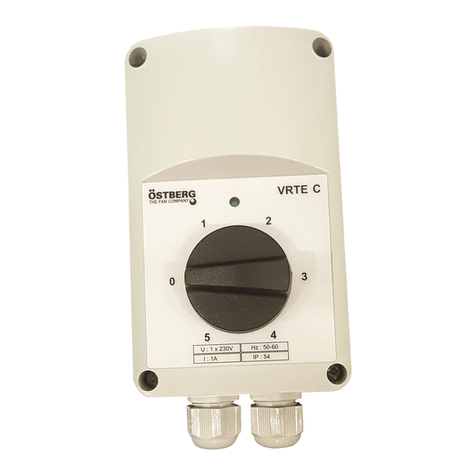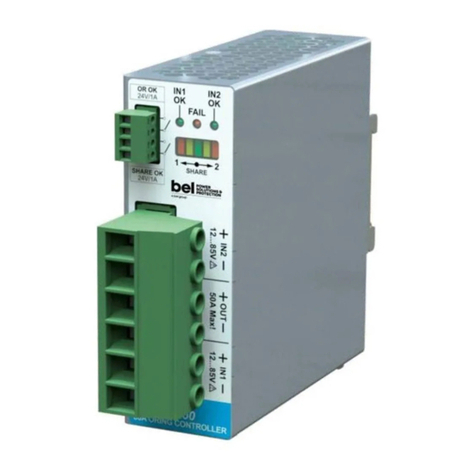FE PETRO EcoVFC Installation instructions

EcoVFC
Installation and Owner’s Manual
Eco VARIABLE FREQUENCY CONTROLLER
Franklin Fueling Systems • 3760 Marsh Rd. • Madison, WI 53718 USA
Tel: +1 608 838 8786 • 800 225 9787 • Fax: +1 608 838 6433 • www.franklinfueling.com
©2016 FFS 228001102 Rev 10

2
Important Safety Messages
FE Petro equipment is designed to be used to pump volatile hydrocarbon liquids such as gasoline and diesel fuel.
Installing or working on this equipment means working in an environment in which these highly ammable liquids are
present. This presents a risk of severe injury or death if these instructions and standard industry practices are
not followed. Read and follow this entire instruction booklet before installing or working on this equipment.
As you read these instructions, watch for the following safety symbols:
Follow all federal, state, and local laws governing the installation of this product and its
associated systems. When no other regulations apply, follow NFPA codes 30, 30A, and 70 from
the National Fire Protection Association. Failure to follow these codes could result in severe
injury, death, serious property damage and/or environmental contamination.
ALWAYS tag and lock breakers so they are not turned on accidentally. If the electrical circuit
breakers are accidentally turned on while the pump is being installed or serviced, electrical
power could be applied to the pump, creating the risk of a potentially lethal electrical shock
hazard and the possibility of an explosion or re from a spark which could ignite hydrocarbon
vapors present during IST installation.
After disconnecting power to the EcoVFC, wait one minute after LED display blanks before
opening the cover for servicing. Voltage stored in the capacitor bank of the EcoVFC presents a
risk of potentially lethal electrical shock even after power is disconnected.
Install this unit only in a non-hazardous area. This equipment is connected to devices located
in hazardouls locations with highly ammable vapors present. Failure to follow all safety could
result in serious re or explosion.
Before entering a containment sump check for the presence of hydrocarbon vapors. If
hydrocarbon vapors are at unsafe levels, ventilate the sump with fresh air, re-check the
atmosphere before entering the sump and periodically thereafter. ALWAYS have a second person
standing by for assistance when working in or around a containment sump. Many submersible
pumps are now housed in containment sumps designed to trap hazardous liquid spills and
prevent contamination of the environment. These containment sumps can also trap dangerous
amounts of hydrocarbon vapors which, if inhaled, could lead to dizziness and fainting, or, if
ignited, could result in an explosion causing serious personal injury or death.
Always disconnect both power supplies (the 110-240 VAC from dispenser hook signals and the
360-440 VAC input power supply) before installing or servicing this system. Failure to do so
could result in death or serious bodily injury.
Installer: This instruction booklet MUST be left with the owner of the service station at which the equipment is being
installed.
Station Owner: Retain these instructions for future use and provide them to persons servicing or removing this
equipment.
Note: Always refer to the Installation and Owner’s Manual that came with the equipment for the most current and
complete list of installation and safety precautions. Where applicable, this manual may also contain notations on
equipment features present in software version 1.14 and higher.
This symbol identies a potentially hazardous situation which, if the instructions that follow it are not adhered
to, could result in death or serious bodily injury.
This symbol identies a potentially hazardous situation which, if the instructions that follow it are not adhered
to, could result in serious property damage, including possible environmental contamination as a result of
the leakage of fuel from the equipment.
Warning
Warning
Warning
Warning
Warning
Warning

3
Field Wire Panel Is the Right Side Panel Located Under the EcoVFC Cover
Figure 1: EcoVFC Wiring
Hook Terminals: Voltage signal from the dispensers to turn pump on. Requires a signal wire and a neutral.
No polarity requirements at the Hook Terminal.
Pump Motor Terminals: Labeled GND, BLK,ORG, RED. Connect wires that go to the submersible pump at
these terminals. If color codes are not matched at the submersible the motor may
run in reverse.
Input Power Terminals: Labeled GND, L3, L2, L1. Supplies power for EcoVFC and the submersible pump.
EcoVFC accomodates type TT or TN grounding congurations.
Apply power to the controller BEFORE allowing hook signal input. (There should be NO hook
signal present when applying power to the controller).
Note: Connect wires accurately. Connecting power wires to any other terminals will cause irreparable damage
to the EcoVFC controller.
Note: The EcoVFC can only be used with FE Petro Pump base models IST, IST VS4, STP VS4, STP VS2, PMA
VS4, or PMA VS2. The EcoVFC is not compatible with competitive makes of variable speed models. The
EcoVFC is compatible with the IST-VFC for communication in Master / Slave congurations only if the
EcoVFC has software revision 1.18 or higher.
Note: This drive requires circuit breakers rated 360-440 volts, 40 Ampere maximum for branch circuit short
circuit protection.
Environment
Ambient Operating Temperature 4ºC - 35ºC
Humidity 93% RH
Storage temperature -20ºC to 65ºC
Pollution Degree 2
Altitude 2,000 Meters above sea level maximum
Do not install in hazardous location
Use only with FE Petro PMA models VS2 and VS4
Use 90ºC copper wire rated 600v minimum
Tighten line and motor terminals to 1 Nm (8 in-lbs)
EcoVFC Electrical Specifications:
EcoVFC Incoming Line Draw:
Three Phase Input = 20A Max.
PMA VS4 Motor Draw = 15A Max.
PMA VS4 Lead-to-Lead
Winding resistance = 1.2 Ohms ± 1 Ohm
PMA VS2 Motor Draw = 7A Max.
PMA VS2 Lead-to-Lead
Winding resistance = 2.5 Ohms ± 1 Ohm
Notice: Incoming power must be three-
phase, including a neutral connection
Hook Terminals
From Dispenser
Pump Motor Te rminals
To STP
110 VAC Supply & Neutral
or
240 VAC Supply & Return
GND
BLK
ORG
RED
GND
L1
L2
L3
N
Input Power Te rminals
360-440 VAC
50 or 60 Hz 3-Phase
Warning

4
User Interface Panel Is the Front Panel Located Under the EcoVFC Cover
(Factory default switch settings shown)
Pump Status
Display
Nylon Screw
USER INTERFACE PANEL
SW6
Configuration Switches
SW1
SW1
Operational Pressure Switch
SW2
Address Switches
SW3
Configuration Switches
2
2
8
5
4
3
7
6
1
0
9
SW2
O
N
1 4
35
SW3
O
N
2
14
356
SW6
784
O
N
13
26
578
Resistive: 5A @ 250VAC or 30VDC
Inductive: 2A @ 250VAC or 30VDC
Closed when submersible pump is running
Normally Open Relay Contact
RS 485 connection
Reset Button
Frequency (F)
2314
Ground (G)
+
-
Silence Alarm/Fault Readout
Button
Communication LED
(N.O. relay sold separately, P/N 228289930)
Nylon Screw
Figure 2: EcoVFC Front Switch Panel
Pump
Status Display: Displays codes that indicate controller or pump status, see the Troubleshooting section
for details of codes.
Silence Alarm/Fault Readout button: Push and it will turn off audible alarm, Push and hold button and the
Pump status display will show the last 3 fault conditions the EcoVFC
encountered.
Reset Button: Resets controller of any fault condition
Communications LED: Used in Master/Slave type congurations to indicate communication activity
RS485 connection: Used in Master/Slave congurations (Frequency connection not used in IST-VFC Mode)
Relay contact: Normally open, the relay closes when the pump is running (relay sold separately).
SW1 Operational Pressure Switch: Adjusts the submersible pump’s operation pressure
SW2 Address Switch: Used in Master/Slave and Turbine Pump Interface (TPI)
Note: TPI is a feature on the TS5 series consoles which allows tank gauge and pump controller communication.
SW3 Conguration switches: Factory Default settings for Stand alone use in Gasoline. See Options Select
Section for other settings.
SW6 Conguration Switch: More conguration options, see Options Select Section for specic settings
Nylon Screw: (P / N 223561102) Attaches the user interface board to the eld wire panel heatsink, required for
high-voltage isolation. Use only factory-supplied parts.

5
Installation Instructions
Note: Steps 1 through 3 are also part of the installation
instructions for the submersible pump. This is done
to make sure all instructions are available if needed
during installation. As a result, steps 1-4 may
already be complete.
1. Connect the electrical conduit with approved
ttings to the submersible pump junction box.
2. Remove the submersible pump junction box cover,
and remove the compression seal by loosening
the screw (do not remove the screw). The seal
has four holes to accommodate a ground wire and
three-phase power from the EcoVFC.
Not installing a ground wire increases
the risk of potentially lethal electrical
shock and equipment failure. All holes
of the compression seal (contractors
plug) must be lled with wires or a
Celcon®rod to enable it to seal.
3. Verify that the power is OFF at the supply box.
Pull four wires from the spot where the EcoVFC
unit will be mounted into the submersible pump
junction box and feed through the compression
seal. Slide the compression seal into place and
tighten securely. Connect the three wires from
the connector assembly to the three phase
power wires coming from the EcoVFC. Connect
the fourth wire (ground) from inside to the pump
junction box ground lug. EcoVFC accomodates
type TT or TN grounding congurations.
Note: All wiring must conform to all applicable guidelines
in accordance with all federal, state, and local
codes. Failure to comply with all applicable
guidelines could result in an unsafe installation.
Use the following table for maximum wire length to
wire gauge for submersible wiring:
Wire Size Maximum Run
5.26 mm2(10 AWG) 200 meters (650 feet)
3.31 mm2(12 AWG) 120 meters (400 feet)
2.08 mm2 (14 AWG) 75 meters (250 feet)
4. Replace the cover of the pump junction box and
securely tighten in place.
The compression seal is not a
replacement for the vapor explosion
seals required by the NEC. All materials
used between the power supply box
and the submersible pump junction
box must be gasoline and oil resistant.
All wiring used within the EcoVFC must
be rated 90°C, 600V minimum. Failure
to comply with these, and all applicable
NEC guidelines, could result in an
unsafe installation.
5. Hang the EcoVFC on a vertical surface and
remove the front panel screw and front cover.
Install approved electrical conduits only at factory
knockouts on the EcoVFC enclosure.
Note: Interference is created by several types of
equipment in a station (uorescent lighting,
compressor, etc.), some more than others; this
interference can affect the operation of more
sensitive equipment (such as tank monitors and
electronic line leak detectors) which communicate
through data lines. When installing the EcoVFC,
FE Petro recommends that the power wires from
the Power Source as well as the power wires
to the IST or STP units with VS2 or VS4 sufx
(pump) be in their own steel conduit which is not
broken or routed through race ways. FE Petro also
recommends that all equipment be installed per the
manufacturer requirements for best results.
Note: The EcoVFC must be mounted indoors in a non-
hazardous location with ambient temperatures
between 4° C (40° F) and 35° C (95° F).
The EcoVFC measures 36.2cm (14.25”)H x 14.25cm
(5.50") W x 24.1cm (9.50") D (Figure 3
).
Note: To allow room for eld adjustments and air
clearance, mount the controllers so they have 6” or
more of clearance on the top, bottom and right side
(cover side) , and 3" or more clearance on the left
side (heat sink side) . Install with the heat sink ns
vertical and the knock-outs down.
36.2 cm
14.0cm 24.1 cm
Figure 3: EcoVFC Dimensions
Warning
Warning

6
6. Refer to Figure 1. Connect the three motor control
wires from the pump junction box to labeled
terminals observing color coding of wires (Black to
Black, Orange to Orange, Red to Red). Connect
the ground wire from the submersible pump to the
ground lug on the EcoVFC circuit board.
To avoid the risk of potentially lethal
electrical shock, re, or explosion,
always tag and lock circuit breakers
in the off position before opening the
EcoVFC.
After disconnecting power to the
EcoVFC, wait one minute after LED
display blanks before opening the
cover for servicing. Voltage stored
in the capacitor bank of the EcoVFC
presents a risk of potentially lethal
electrical shock even after power is
disconnected.
Note: If the motor power wires are not connected with
the proper polarity, the motor will run in reverse
rotation causing output pressures of approximately
1.2 - 2.0 bar (17-29 psi) with a PMA VS4 and
approximately 0.7 - 1.2 bar (10-18 psi) with a PMA
VS2 connected.
7. Connect three phase, 360-440V, 50 or 60Hz power
supply to terminals to N, L1, L2 and L3. Reference
Figure 1 for wiring details.
Note: The EcoVFC must be connected to three-phase
power only. If 200-250V, 50 Hz, Single Phase
power supply is only available, the EcoVFC must
be replaced with the FE Petro MagVFC, which
will olny be capable of driving a PMA VS2 in this
application.
Do not connect incoming power to
any terminals other than L1, L2, and
L3. Connecting input power to any
other terminals will cause failure and
permanent damage to the EcoVFC.
There must be NO hook signal present
when applying power to the controller.
8. Connect dispenser hook signal to the two position
terminal block on the EcoVFC board as shown in
Figure 1.
Note: Dispenser hook terminals are capable of accepting
voltages from 110 VAC through 240 VAC
dispenser signals. The dispenser hook terminals
require a signal wire from the dispenser and a
Neutral / Return.
9. Conguration switches are factory set for PMA
VS2 in gasoline, mechanical leak detectors,
extended run active, and stand-alone operation
as detailed below in Figure 4. If you are using
a different conguration see the Option Select
section of this manual.
per table 1
serial address (SW2)
Set all switches of
SW3 poles 4&5 on
master and slave(s)
must match
Set Pressure
Select (SW1) to
same position fo
r
all units
SW2
SW3
312 4
SW6
MASTER
SW2
SW3
312 4
Additional Slave(s)
Connections
SW6
SLAVE
Figure 4: EcoVFC Factory Switch Settings
Warning
Warning
Warning
Warning

7
Optional Select Switch Settings
10. To make changes to the conguration switches
SW3 and SW6 (See Figure 4), make sure power
supply is locked and tagged out, then remove
the two screws from the plastic shield covering
the User interface board. Set all DIP switches as
desired per the details below.
SW3 Pole 1
ON for Mechanical Leak Detectors (factory
setting)
OFF For Some Electronic Line Leak Detection
systems. Required setting for Veeder Root PLLD.
SW3 Pole 2
ON for Gasoline (factory setting)
OFF for Diesel product
Note: Because gasoline has a different specic gravity
than diesel fuel, the correct setting of Pole 2 is
important to ensure that the EcoVFC regulates
pressure at the desired level.
SW3 Pole 3
ON for Master controller (See Master Slave
Control Connections for details)
OFF for Stand-alone operation or Slave
conguration (factory setting)
SW3 Poles 4 and 5 (Pipe Compensation)
See Calibration Section of this Manual for
details in setting these switches (default is ON,
ON)
SW3 Pole 6
ON when using PMAVS4 motor
OFF when using PMAVS2 motor (factory
setting)
Note: Incorrect setting can cause the EcoVFC to
give false indications of SC (short circuit) or
UL (underload). Set SW3 Pole 6 properly to
horsepower of pump connected.
SW3 Pole 7
ON for Automatic reset of “Under Load” fault.
An empty tank will cause an Under load fault.
The EcoVFC will automatically reset when the
condition is corrected.
OFF must push Reset button to clear the
“Under Load” fault (factory setting)
Note: Not functional in IST-VFC Compatibility Mode,
leave in OFF position.
SW3 Pole 8 (for multiple EcoVFC controllers
working together)
See Alternating Circuit Control section for
details (default is OFF)
Note: Not functional in IST-VFC Compatibility Mode, set
with SW2 Pole 5 per Table 1A.
SW6 Pole 1
See Troubleshooting section for details of the Extended
Run Alarm
ON Will disable the Extended Run Alarm
condition
OFF The Extended Run Alarm is active
(factory setting)
Note: Not functional in IST-VFC Compatibility Mode,
leave in OFF position.
SW6 Pole 2 (For Master-Slave and Alternating
Circuit congurations ONLY)
See Master-Slave Fault Shutdown Control
section for details of this switch (default is OFF)
Note: Not functional in IST-VFC Compatibility Mode, set
with SW2 Pole 5 per Table 1A.
SW6 Pole 3
ON for IST-VFC Compatibility Mode, unit will
then ONLY communicate with rev 1.5 software
IST-VFCs in Master-Slave congurations (not
for use in communicating Master-Slave with
other EcoVFCs)
OFF native EcoVFC Master-Slave
communication (factory setting)
Note: Available in EcoVFC software versions 1.18 and
higher only.
SW6 Pole 4
(With software version 1.24 or higher)
ON When the alternating circuit conguration is
used this will alternate submersibles every 30
minutes when a hook signal is continuous. This
option is used to assist in keeping tanks balanced
at busy sites.
OFF When Alternating Circuit is not needed.
(See page 11 for additional details)
SW6 Pole 5
ON With software version 1.24 this feature, called
Proportional Alternating Circuit, allows setting the
time each controller runs before it alternates. The
feature this will help manage tank levels but will
not replace a syphon bar or managing levels via
INCON T5 series Automatic tank gauges “leveling”
mode. (See page 12 for a detailed description).
OFF When Proportional Alternating Circuit is not
needed.

8
SW6 Poles 6 - 8
These switches are not used. Leave them in
the OFF position.
Note: EcoVFC may operate in an unpredictable manner if
any of the switches, SW6 Poles 6-8, are in the ON
position.
11. Replace the cover of the EcoVFC.
12. Insert a 0 - 7 bar (0 -100 psi) pressure gauge into
the 1/4” line test port of the submerged pump
(or other pressurized test location in the piping
system). Turn power on to the EcoVFC at the
load center, turn on the submerged pump at the
dispenser and inspect the line test port for leaks.
If there are any leaks, immediately turn off the
submerged pump at the dispenser and the load
center and repair the leaks.
13.
Begin purging the air from the piping system by
activating a dispenser handle and pumping product
into an approved container. Verify that while the
pump is on but no product is being dispensed,
the pressure reading on the gauge is equal to the
related pressure from Table 4 in Step 22,
+0.3 / -0.5 bar (+5 / -7 psi).
Note: If pressure in the piping system is much lower than
selected, it is possible that the polarity of the motor
power wires is not correct, causing the motor to
run in reverse rotation. Turn off the pump at the
power supply, (wait one minute after LED display
blanks before opening the cover) and change the
connection of any two wires at the pump or at the
EcoVFC motor terminals. Turn the pump back on
and read the pressure gauge again. The electrical
connection, which gives the higher reading on the
pressure gauge, is the correct one.
14. Complete purging the remaining air from the piping
system and dispensers. If using Master-Slave or
Master-Slave/Alternating Circuit, continue with
next section. If not, go to “EcoVFC Site Set-Up”
section.
Master-Slave Control Connections
Note: For Master / Slave and Alternating congurations,
the EcoVFC can only be paired with other
EcoVFC’s. Because of enhanced communication
protocols, the EcoVFC is not capable of
communication with the IST-VFC unless SW6 Pole
3 (IST-VFC Compatibility Mode) is switched ON.
IST-VFC Compatibility Mode is available in rev 1.18
software or higher EcoVFCs.
To avoid the risk of potentially lethal
electrical shock, explosion or re,
always tag and lock circuit breakers
in the off position before removing the
cover of the EcoVFC.
After disconnecting power to the
EcoVFC, wait one minute after LED
display blanks before opening the
cover for servicing. Voltage stored
in the capacitor bank of the EcoVFC
presents a risk of potentially lethal
electrical shock even after power is
disconnected.
15. When two IST pumps or STP units with VS4
or VS2 sufx are installed to be run in parallel
(discharging into the same line) three different
modes of operation are possible, as follows:
Master – Slave
When a hook voltage is present at the Master it will turn
on. When demand for product increases (more nozzles
open) the Master will call the Slave controller to turn on.
This will maintain the product ow rate in high demand
situations. In this conguration, the slave unit(s) will run
only when requested to do so by the master unit.
Alternating Circuit
The controllers will rotate being the one to turn on as the
hook voltage turns on and off. Only one controller is on
at a time in this conguration. Not available in IST-VFC
Compatibility Mode.
Master – Slave and Alternating Circuit
A combination of the above two congurations. The rst
controller to turn on rotates and when the demand for
product increases, additional controllers will be called on to
assist.
See Figure 5 wiring diagram for the RS485 connections.
16. For Master – Slave Conguration (not applicable
to IST-VFC Mode)
Set Master SW3 Pole 3 to ON, SW3 Pole 8 to
OFF,and verify that on SW2 all switches are
OFF.
Set Slave(s), verify that SW3 Pole 3 and SW3
Pole 8 are set OFF (factory default). Set SW2
switches of Slave(s) per Table 1.
Warning
Warning

9
For Alternating Circuit Conguration (not
applicable to IST-VFC Mode)
Set Master SW3 Pole 3 to OFF, SW3 Pole 8
to ON and SW2 switches all OFF
For Slave(s), SW3 Pole 3 is set OFF (factory
default), SW3 Pole 8 to OFF and SW2 switches
per Table 1.
For Master – Slave and Alternating Circuit
Conguration (not applicable to IST-VFC Mode)
Set Master SW3 pole 3 and SW3 Pole 8 are
ON and SW2 switches all OFF
For Slave(s), SW3 Pole 3 and SW3 Pole 8 are
OFF and SW2 switches per Table 1
Note: For IST-VFC Compatibility Mode (SW6 Pole 3 ON),
set Master SW3 pole 3 ON, set Slaves(s) SW3
pole 3 OFF, and set SW2 switches per Table 1A.
Line leak detection performance can be
affected when using multiple EcoVFCs.
FE Petro does not recommend using
the Alternating Circuit feature in
conjunction with electronic line leak
detection. Some electronic line leak
detector manufacturers require that
the Master turn on rst all of the time.
Please refer to the manufacturer’s
requirements.
Caution
RS485 wiring for Master/Slave and Alternating congurations
per table 1
serial address (SW2)
Set all switches of
SW3 poles 4&5 on
master and slave(s)
must match
Set Pressure
Select (SW1) to
same position for
all units
SW2
SW3
312 4
SW6
MASTER
SW2
SW3
312 4
Additional Slave(s)
Connections
SW6
SLAVE
Figure 5: Setup Master / Slave Conguration

10
17. Another feature of the Master-Slave and / or
Alternating Circuit congurations is the ability to
have a Slave take command for product delivery
if one of the following alarm conditions is present
with the Master:
• Underload (Tank Empty)
• Low Incoming Voltage
• Locked Rotor in PMA
• High Temperature in EcoVFC
• Over Speed
SW6 pole 2 (This option only needs to be
selected on the Master controller)
ON an alarm condition on any controller will shutdown
all controllers. Required setting for VR PLLD.
OFF an alarm condition will shutdown only the
controller with the alarm. (factory setting)
When this option is selected, switch ON, the entire system
will shutdown if any of the controllers, Master or Slaves,
alarms. The system will not run until the alarm is corrected
and the reset button is pushed or the Fault Shutdown
option switch is turned OFF and the reset button is pushed.
18. Wire the RS485, connecting the master EcoVFC
to the slave(s) EcoVFC as shown in Figure 5. Wire
per NFPA 30A, and NFPA 70. For the signal wires,
use at least 0.326 mm2(22 AWG) (600V minimum)
4 conductor shielded cable with a drain and within
a common jacket. Cut wires to length so that
there is no excess wiring touching circuit board
components.
Note: When wiring a Master - Slave and / or Alternating
Circuit set, connect the signal from the dispenser
(hook) to the terminals of the Master EcoVFC only.
The Master controller will energize the Slave(s)
when needed without a signal from the dispenser.
19. When all connections are complete, reinstall the
EcoVFC covers and activate supply power. Verify
that the front panel status indicator is displaying Id
(Idle) for both Master and Slave(s)
No
te:
When working with a Master-Slave or Master-Slave/
Alternating Circuit conguration, there can be one
Master and up to (31) slaves. When connected properly,
the yellow Communication LED will ash quickly on the
Master unit and ash in sequence through the Slave
unit(s). See Figure 2 for LED location.
Table 1 – Native EcoVFC Communication Addressing: SW2 (see Figure 2 for location of switch)
Address Pole 1 Pole 2 Pole 3 Pole 4 Pole 5
Master Off Off Off Off Off
Slave - 1 On Off Off Off Off
Slave - 2 Off On Off Off Off
Slave - 3 On On Off Off Off
Slave - 4 Off Off On Off Off
Slave - 5 On Off On Off Off
Slave - 6 Off On On Off Off
Slave - 7 On On On Off Off
Slave - 8 Off Off Off On Off
Slave - 9 On Off Off On Off
Slave - 10 Off On Off On Off
Slave - 11 On On Off On Off
Slave - 12 Off Off On On Off
Slave - 13 On Off On On Off
Slave - 14 Off On On On Off
Slave - 15 On On On On Off
Slave - 16 Off Off Off Off On
Slave - 17 On Off Off Off On
Slave - 18 Off On Off Off On
Slave - 19 On On Off Off On
Slave - 20 Off Off On Off On
Slave - 21 On Off On Off On
Slave - 22 Off On On Off On
Slave - 23 On On On Off On
Slave - 24 Off Off Off On On

11
Table 1A – Compatibility Mode Addressing & IST-VFC Master-Slave Options
SW2 (see Figure 2 for location of switch)
Address Pole 1 Pole 2 Pole 3 Pole 4 Pole 5
Master-Slave
Pole 5
for Master-Slave
Alt. Circuit
Master Off Off Off Off On Off
Slave - 1 Off Off Off On On On
Slave - 2 Off Off On Off On On
Slave - 3 Off Off On On On On
Slave - 4 Off On Off Off On On
Slave - 5 Off On Off On On On
Slave - 6 Off On On Off On On
Slave - 7 Off On On On On On
Slave - 8 On Off Off Off On On
Slave - 9 On Off Off On On On
Slave - 10 On Off On Off On On
Slave - 11 On Off On On On On
Slave - 12 On On Off Off On On
Slave - 13 On On Off On On On
Slave - 14 On On On Off On On
Slave - 15 On On On On On On
Table 2 — Summary of Master /Slave 30 minute Alternating Setup
(Software version 1.24 or higher)
Below is a table summarizing the SW3 and SW6 settings to enable the EcoVFC to alternate active pumps every 30
minutes as described on page 9 (See gure 10 for switch settings).
SW6 DIP Switch Master Slave Description Image
8Off Off Not Used
6
SW6
Master
O
N
21 34 5 7 8
6
SW6
Slave
O
N
21 34 5 7 8
7Off Off Not Used
6Off Off Not Used
5On On Master / Slave Turn On
4On On Alternating Circuit Proportioning
3Off Off IST / ECO
2Off Off Master / Slave Shutdown
1Off Off Extended Run
SW3 DIP Switch Master Slave Description Image
8On Off Alternating Circuit
6
SW3
Master
O
N
21
3 4 5 7 8
6
SW3
Slave
O
N
21 34 5 7 8
7Off Off Auto UL Reset
6Off Off VS2 (On for VS4)
5Off Off Pipe Compensation
4Off Off
3Off Off Master / Slave
2On On Gas (Off for Diesel)
1Off Off PLLD

12
EcoVFC Proportional Alternating Circuit
Feature (Software Version 1.24)
To enable the Proportional Alternating Circuit feature on the
EcoVFC with software version 1.24 or higher:
Set SW3 position 8 to the ON Position.
Set SW6 position 4 to the ON position. This activates
the timed alternating circuit mode. This switch
needs to be enabled on the master EcoVFC only.
Set SW6 position 5 to the ON position. This switch
activates the proportioning feature and needs to be
enabled on the master EcoVFC only.
Set SW2 to the desired address for pump run time.
Each EcoVFC address will be set based on the
time it needs to run (Table 3).
Note: This is different from the typical Master EcoVFC
address of “0” (See gure 6 for switch locations).
Example:
• For a Master controller with a 20,000 gallon tank,
when set to address 20 the pump will run for 30
minutes.
• For a Slave controller with a 12,000 gallon tank,
when set to address 12 the pump will run for 18
minutes.
• For another Slave controller in an 8,000 gallon
tank, when set to address 8 the pump will run for 12
minutes.
Any address can be set, as long as the addresses are
unique between controllers. Typically addresses and
run times will be chosen that are proportional to the tank
sizes. The example shows 3 different size tanks and the
addresses that run the pumps in proportion to the tank size.
Address
(SW2)
SW2 DIP
= On Timed AC
Minutes ON
1 2 3 4 5
0 1.5
1 1.5
2 3
3 4.5
4 6
5 7.5
6 9
7 10.5
8 12
9 13.5
10 15
11 16.5
12 18
13 19.5
14 21
15 22.5
16 24
17 25.5
18 27
19 28.5
20 30
21 31.5
22 33
23 34.5
24 36
25 37.5
26 39
27 40.5
28 42
29 43.5
30 45
31 46.5
Table 3: SW2 DIP Switch Settings

13
1
J231
32 4
Master EcoVFC
8
2
SW1
3
6
5
4
7
0
9
1
SW2
O
N
1345
28
SW3
3
O
N
126
45 7
SW6
O
N
1 62 43 5 87
SW3
6
SW6
O
N
21
3 4 5
7 8
6
O
N
21
3 4 5
7 8
SW2
SW6, position 5 = ON
SW6, position 4 = ON
SW3, position 8 = ON
Set according to Table 3. Each controller
address must be unique.
Figure 6: Switch Settings for Proportional Alternating Setup

14
EcoVFC SITE SET UP
20. Verify rotary switch on EcoVFC is set to
position 4. This will provide approximately 2.2 bar
(32 psi) output from the IST or STP units with VS2
or VS4 sufx, and serves as a good starting point
for EcoVFC calibration.
21. Using a 19 liter (5 gallon) capacity minimum
approved container, go to the dispenser closest
to the storage tank and perform a Flow Rate Test.
If the product being pumped is gasoline, consider
following the U.S. EPA Fuel Dispenser Flow Rate
Test Procedure for 38 LPM (10 GPM) maximum
ow rate standard, where applicable.
Note: It is necessary to perform a Flow Rate Test for each
product available at the dispenser. This will conrm
that all product outputs, including products blended
at the dispenser, do not exceed the U.S. EPA 38
LPM (10 GPM) maximum, where applicable.
Note: Use of “ow restrictors” to control a maximum ow
rate of 38 LPM (10 gpm) per nozzle (as required
by the U.S. EPA) are not required if the variable
frequency controller is properly calibrated as
dened in “EcoVFC Site set up Section” section.
22. If output is above or below the desired range (i.e.
30 -38 LPM or 8-10 GPM), turn off the pump at the
power supply, (wait one minute after LED display
blanks before opening the cover) remove the
EcoVFC cover, and adjust the rotary switch (SW1),
see Figure 2. This switch will increase or decrease
the system operating pressure according to Table
4. An increase in pressure will normally yield an
increase in ow rate; a decrease in pressure will
reduce ow rate. Replace the EcoVFC cover and
re-apply input voltage. Return to Step 21 above
and check LPM (GPM) with the new settings.
Repeat until the output obtained is within the
desired range in LPM (G
PM).
Switch
Position Pressure
0 1.7 bar (24 psi)
1 1.8 bar (26 psi)
2 1.9 bar (28 psi)
3 2.1 bar (30 psi)
4 2.2 bar (32 psi)
5 2.3 bar (34 psi)
6 2.5 bar (36 psi)
7 2.8 bar (38 psi)
8 2.9 bar (40 psi)
9 42 psi
Table 4: SW1 Settings
To avoid the risk of potentially lethal
electrical shock, explosion or re,
always tag and lock circuit breakers
in the off position before removing the
cover of the EcoVFC.
After disconnecting power to the
EcoVFC, wait one minute after LED
display blanks before opening the
cover for servicing. Voltage stored
in the capacitor bank of the EcoVFC
presents a risk of potentially lethal
electrical shock even after power is
disconnected.
Note: Additives in gasoline can change the specic
gravity of gasoline, which may cause the pressures
stated in the above Table 4 to vary.
23. Optimize Pipe Compensation settings by doing
another Flow Rate Test; this time with two other
nozzles from the same product open at the same
time as your test nozzle. If the ow rate at the
test nozzle falls from the desired range with three
nozzles open, increase SW3 pole 4 and pole 5 to
the next highest compensation setting (0 to 1 or
1 to 2 for example). If output exceeds the desired
range, decrease to the next lowest compensation
setting (2 to 1 or 1 to 0 for example). Repeat this
step until compensation setting is optimal for your
installation. Factory setting is zero.
SW3 pole 4 and pole 5
Compensation SW 3
Pole 4
SW3
Pole 5
Piping
Conguration
0on on least restrictive
1on off ...
2off on ...
3off off most restrictive
Table 5
Note: An example of a small restriction piping system
would be 2" berglass running less than 45m
(150'). An example of a restrictive piping system
would be 1 ½" convoluted exible piping greater
than 23m (75') in length.
Note: When working with a Master-Slave or Master-
Slave/Alternating Circuit conguration, the piping
compensation must be identical in all controllers.
Factory Setting>
Warning
Warning

15
Display Denitions
The EcoVFC is equipped with a display that indicates several operating parameters of the EcoVFC as well as
indicates an error code when a fault is detected. When the EcoVFC is in an error condition, the alarm code will
be displayed. The alarm code denitions and proposed troubleshooting methods are in the Troubleshooting
section of this manual.
Code Denition Description Displayed
Id Idle No hook signal present, PMA is not running, and no fault
codes present
When Pump is idle
(i.e. no hook signal
is present)
xx : yy Software revision
Software version of EcoVFC where numeric value xx
displays and then value yy to form the revision xx.yy
Note: If the display stops on yy, there may be an issue of
low incoming voltage or loose input power connections.
Immediately after
the EcoVFC has
been reset or
turned ON
Pr : NN Pressure regulate
Pr is the pressure setting of NN psi that the EcoVFC is set to
maintain. Pr and the numeric value NN of the set pressure
will ash alternately on the display when running
EcoVFC is running
and operating
within pressure
regulate setting
PL Power Limit Displayed when EcoVFC is operating at its power limit
EcoVFC is running
and operating
beyond pressure
regulate setting
Sr Slave running Displayed when a slave in a Master-Slave conguration is
running
On slave pump
only when
operating
Table 6: Status Codes
Note: The above codes are Status Codes and do not indicate an alarm condition.
See Troubleshooting section for Alarm Codes.

16
Troubleshooting Guide
To help eld service personnel, the EcoVFC can diagnose abnormal operating conditions, and communicate them via the
display on the front panel. The display indicates the operating status of the controller and, if an alarm is present, displays
the alarm condition. The following tables show the alarm codes, as well as provide suggested troubleshooting steps.
The EcoVFC is also equipped with a Reset Button to clear faults and a Silence Audible Alarm Button that turns off the
audible alarm when depressed. Depressing the silence audible alarm button does not clear the fault; it only silences the
alarm. Pushing and holding the Silence Button will put the Pump Status Display in fault readout mode, showing the last
3 fault conditions encountered by the EcoVFC, ie. F0 is followed by the code of the last fault encountered, F1 is second
to last fault encountered, F2 is third to last fault encountered (sequence through the codes by briey pushing the Silence
Button after each code is displayed until the Pump Status Display returns to normal status).
Code Condition Potential
Causes Proposed Action
UL Under-load,
Tank Empty
Incorrect
horsepower
setting
Low fuel level in
the storage tank
Obstruction on
intake of PMA
SW3 Pole 6 set
incorrectly for
pump connected
1. Push reset button on the EcoVFC.
2. If condition is corrected, check for proper operation of system; if
operating correctly do not continue to next step. If condition is still
present continue to next step.
3. Check SW3 Pole 6 setting and verify that it matches the
horsepower of the pump connected. Connecting VS2 motor with
a SW3 Pole 6 ON (4hp) setting, may cause this false indication
when operating in SW1 positions 0 - 6.
4. Check fuel level in storage tank; if product level is low schedule
fuel delivery, when delivery is complete and fuel level is above
PMA end bell, push reset button on EcoVFC Check for correct
system operation.
5. If condition is not corrected, it is possible that there is an
obstruction (rag or absorbent pad) on the inlet of the PMA.
LI Low
Incoming
Voltage
Voltage
uctuations or
low input voltage.
1. Push reset button on the EcoVFC.
2. If condition is corrected, check for proper operation of system; if
operating correctly do not continue to next step. If condition is still
present continue to next step.
3. Use AC voltmeter to verify incoming voltage is within the 360-
440VAC acceptable range. If voltage is not within this range,
contact an electrician to correct problem.
LU Locked Rotor
fault at PMA
startup
Foreign material
in PMA or
defective PMA.
1. Push reset button on the EcoVFC.
2. If condition is corrected, check for proper operation of system; if
operating correctly do not continue to next step. If condition is still
present continue to next step.
PMA Inspection
3. Disconnect input voltage at load center, lock and tag circuit
breakers.
4. Remove two 9/16” bolts from extractable portion of the manifold.
Disengage the 3/4” securing bolt of the electrical connector and
swing out of the way.
5. Pull extractable part of the pump.
Note: Pump Motor Assembly shell can be damaged by blows from hard
surfaces; use care in removing it.
6. Remove black end cap from PMA and attempt to spin rotor with a
3/16" Allen wrench to determine if there is any binding. If binding
or physical damage, continue with next step. If no binding or
physical damage to the PMA, and it is a new installation, reinstall
extractable.
(Continued on next page)

17
Code Condition Potential Causes Proposed Action
LU (cont.) Locked
Rotor fault
at PMA
startup
(con’t)
(see note
below)
Foreign material in PMA
or defective PMA.
7. Turn on the power to the EcoVFC unit and verify correct
system operation. If condition is corrected, do not
continue to the next step. If condition is still present,
remove the extractable (repeat Steps 3, 4, and 5) and
continue to the next step.
Note: PMA can have a locked rotor during startups if it has
been exposed to a corrosive environment, such as a tank
ballasted in water.
8. Remove four 5/16” cap screws that connect the PMA with
¼” Allen wrench and remove the PMA from the motor
discharge head.
Note: Prior to mounting a new PMA, check lead assembly (wires
inside the extractable portion to PMA) for shorted wires
which may have caused the condition.
9. Replace with a new variable speed (PMAMVS4 or
PMAVS2) pump motor.
Note: Pump motor shell can be damaged by blows from hard
surfaces; use care in replacing.
10. Re-install extractable and secure by following reverse
order of disassembly.
11. Turn on power to the EcoVFC unit and verify correct
system operation.
Note: In rare installations where motor wiring runs are extremely long and / or of a small wire diameter, a false LU (locked
up) may be displayed on the EcoVFC. See the table of recommended maximum wire length to wire gauge for
submersible wiring in the beginning of this manual.
Code Condition Potential Causes Proposed Action
Er Extended
Run
Continuous hook signal
applied for greater than
60 minutes without
change in pumping
product ow rate
1. Disconnect power at load center. Lock and tag out circuit
breaker.
2. Check voltage across hook terminals with all dispenser
handles off. There should be no voltage applied. If
voltage is present, contact an electrician to correct the
problem. After the problem has been corrected, turn on
input power and verify system is operating correctly.
SU Upper rail
short
Short Circuit condition in
eld wiring or component
failure internal to the
EcoVFC
1. Press reset button on EcoVFC
2. Check for proper operation.
3. If fault re-occurs turn off power to EcoVFC, lock out and
tag circuit breaker. Disconnect the wires to the STP at
the controller terminals marked Black, Orange and Red.
4. Use wire nuts and cap each wire off to prevent any
possible shorts in the controller. Turn power on to
the EcoVFC and observe the display. If the controller
indicates an OC (open circuit) condition follow the
troubleshooting steps for a short circuit
5. If controller display indicates the SU (upper rail short)
condition then replace the EcoVFC.
rI Capacitor
bank
Bad EcoVFC
capacitor bank
1. Push reset button on the EcoVFC.
2. If fault condition still exists, replace EcoVFC unit.
3. If fault is cleared observe the EcoVFC in normal
operation for approximately 10 minutes to see if it
functions normally. If error resurfaces, replace EcoVFC.

18
Code Condition Potential Causes Proposed Action
OS Over
Speed
EcoVFC operating
outside of range of
operating frequency
1. Press reset button to reset EcoVFC
2. Check for proper operation. If condition is still present,
power down unit completely and wait 30 seconds.
3. Turn on power and check for proper operation.
4. If fault re-occurs, replace EcoVFC
OC Open
circuit
(from
EcoVFC to
motor)
(see note
below)
Connection broken from
EcoVFC to PMA
1. Push reset button on the EcoVFC.
2. If condition is corrected, check for proper operation of
system; if operating correctly, do not continue to next
step. If condition is still present continue to next step.
EcoVFC/PMA Connections
1. Disconnect power at load center, lock and tag circuit
breakers.
2. Remove the three motor control outputs from the
EcoVFC unit.
3. Using an ohmmeter on 200 Ω setting, place leads
between these three wires from the pump motor, this is
the rst step in determining where the open circuit has
occurred. Correct reading between any two of the three
wires should be 1.2 + / -1 ohms for a VS4 and 2.5 + / -1
ohms for a VS2.
4. Continue conductivity tests on the remaining
combinations of wires (3 total). Note results, e.g. Black
to red = 2 ohms. Readings between any of the three
motor control wires and ground should be an open
circuit. If readings in this step are incorrect go to Step
7; if readings are correct, contact FE Petro Technical
Support for assistance.
5. Go to the submerged turbine and remove the cover at
the top of the extractable manifold; remove the three
wire nuts.
6. Place an ohmmeter between the three wires leading to
the pump motor as above. If readings are incorrect go
to PMA replacement in 3 ashes section; if readings are
correct, there is problem with the wiring between the
EcoVFC and this point.
7. Remove the junction box cover and do conductivity
test on wires from junction box to extractable discharge
head. If wires are not conducting replace the male and
female connectors of the submerged turbine. If there is
no problem with these connections the wires from the
EcoVFC to the submerged turbine are suspect. Contact
an electrician to correct the problem.
8. After the problem has been corrected turn on power to
EcoVFC and verify system is operating correctly.
Note: In rare installations where motor wiring runs are extremely long and/or of a small wire diameter, a false
OC (open circuit) may be displayed on the EcoVFC. See the table of recommended maximum wire length
to wire gauge for submersible wiring in the beginning of this manual.

19
Code Condition Potential
Causes Proposed Action
SC Short circuit
Incorrect
horsepower
setting
Short in
connections from
EcoVFC to PMA
SW3 Pole 6 set
incorrectly for
pump connected
1. Push reset button on the EcoVFC.
2. If condition is corrected, check for proper operation of system;
if operating correctly, do not continue to next step. If fault is still
present continue to next step.
3. Check SW3 Pole 6 setting and verify that it matches the
horsepower of the pump connected. Connecting VS4 motor with
a SW3 Pole 6 OFF (2hp) setting may cause this false indication.
EcoVFC/PMA Connections
1. Disconnect power at load center, lock and tag circuit breakers.
2. Remove the three motor control outputs from the EcoVFC unit.
3. Using an ohmmeter on 200 setting, place leads across any
two of the three wires from the pump motor. Correct reading
between any two of the three wires should be 1.2 + / -1 ohms for
a VS4 and 2.5 + / -1 ohms for a VS2.
4. Continue conductivity tests between each of the three motor
control wires and ground. If readings are greater than 80k Ω
proceed to Step 8. If readings are less than 80k Ω the possibility
of a short circuit in the connections from the EcoVFC to PMA
exists.
5. Go to the submerged turbine and remove the cover at the top of
the extractable; remove the three wire nuts.
6. Place an ohmmeter between the three wires leading to
the pump motor as above. If wires are shorted go to PMA
replacement in 3 ashes section; if readings are correct there is
problem with the wiring between the EcoVFC and this point.
7. Remove the junction box cover and do conductivity test on
wires from junction box to extractable discharge head. If wires
are shorted to ground or each other, replace the male and
female connectors of the submerged turbine. If there is no
problem with these connections the wires from the EcoVFC to
the submerged turbine are suspect. Contact an electrician to
diagnose and correct the problem.
8. After the problem has been corrected turn on power to the
EcoVFC and verify system is operating correctly. Contact
FE Petro Technical Support for additional troubleshooting
assistance.
HO High
temperature Excessive
operating
temperature in
EcoVFC
1. Verify that fan is running properly. If not, replace Fan.
2. Check excessive heat in area where control box is mounted.
3. Verify all louvers for ventilation are free from obstruction.
Remove obstruction and cycle power to reset EcoVFC.
4. If neither of these conditions exist, replace EcoVFC unit.
Lr Locked rotor
fault with
PMA running
Foreign material in
PMA or defective
PMA
1. Push reset button on the EcoVFC.
2. If condition is corrected, check for proper operation of system; if
operating correctly, do not continue to next step. If condition is
still present continue to next step.
PMA Inspection
3. Disconnect input voltage at load center, lock and tag circuit
breakers.
4. Remove two 9/16" bolts from extractable portion of the manifold.
Disengage the 3/4" securing bolt of the electrical connector and
swing out of the way.
(Continued next page)

20
Code Condition Potential
Causes Proposed Action
Lr
Locked rotor
fault with
PMA running
(con’t)
(see note
below)
Foreign material in
PMA or defective
PMA
(con’t)
5. Pull extractable part of the pump.
Note: Pump Motor Assembly shell can be damaged by blows from
hard surfaces; use care in removing it.
6. Remove black end cap from PMA and attempt to spin rotor with a
3/16” Allen wrench to determine if there is any binding. If binding or
physical damage, continue with next step. If no binding or physical
damage to the PMA, and it is a new installation, reinstall extractable.
7. Turn on the power to the EcoVFC unit and verify correct system
operation. If condition is corrected, do not continue to the next step.
If condition is still present, remove the extractable (repeat Steps 3, 4,
and 5) and continue to the next step.
Note: PMA can have a locked rotor during startups if it has been
exposed to a corrosive environment, such as a tank ballasted
in water.
8. Remove four 5/16" cap screws that connect the PMA with ¼” Allen
wrench and remove the PMA from the motor discharge head.
Note: Prior to mounting a new PMA, check lead assembly (wires inside
the extractable portion to PMA) for shorted wires which may
have caused the condition.
9. Replace with a new variable speed (VS4 or VS2) pump motor.
Note: Pump motor shell can be damaged by blows from hard surfaces;
use care in replacing.
10. Re-install extractable and secure by following reverse order of
disassembly.
11. Turn on power to the EcoVFC unit and verify correct system operation.
Note: In rare installations, a partial short can result from a nick in one of the pump power wires coupled with
water in the electrical conduit from the EcoVFC to the pump. This condition is not a direct short, so the
EcoVFC does not ash short circuit (SC). Instead, the EcoVFC will see this condition as abnormally high
power consumption, and ash locked rotor (LR).
EcoVFC Replacement Parts
Description Part Number
Fan Assembly 223919930
User Interface Board 225040930
Normally Open Relay 228289930
Window Lens 402623930
Nylon Screw 223561102
Table of contents
Other FE PETRO Controllers manuals
Popular Controllers manuals by other brands

INSTEON
INSTEON 5010A quick start guide
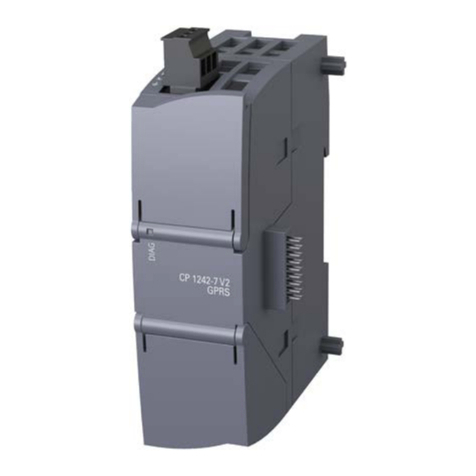
Siemens
Siemens S7-1200 TELECONTROL operating instructions
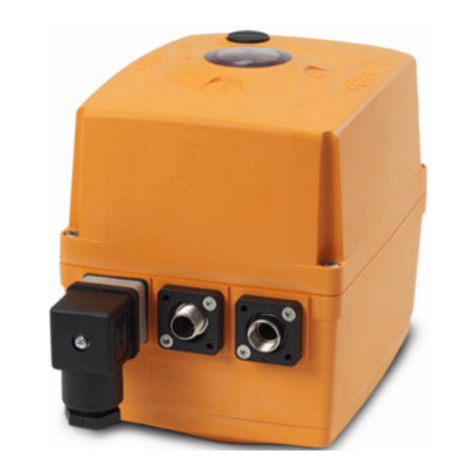
GF
GF Profibus DP-V0 instruction manual
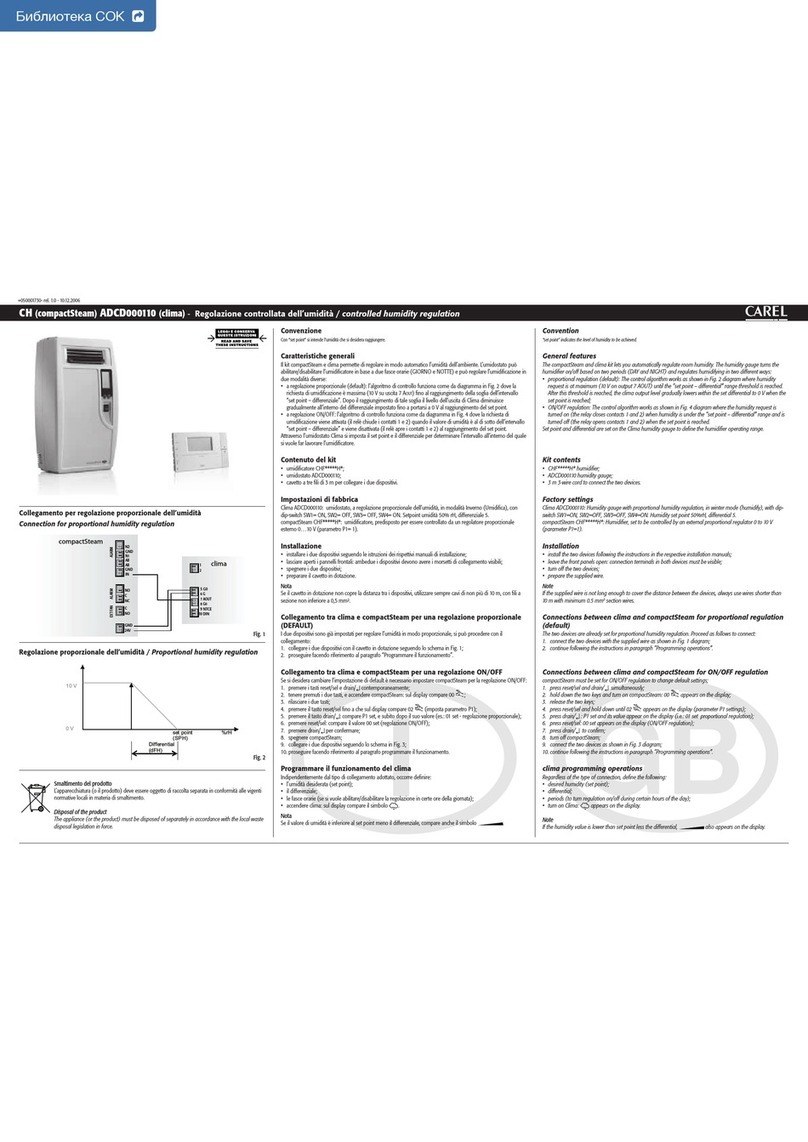
Carel
Carel ADCD000110 quick start guide
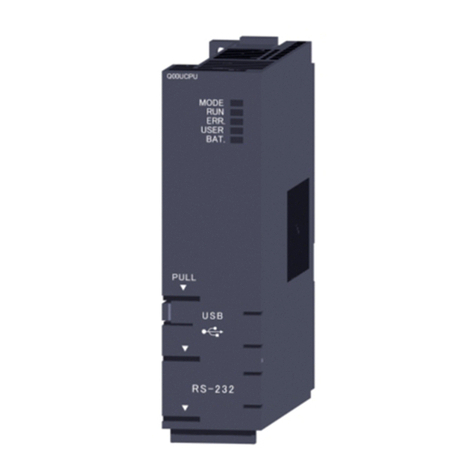
Mitsubishi Electric
Mitsubishi Electric MELSEC Q Series user manual

Pulsafeeder
Pulsafeeder MicroVision EX Installation & operation manual

